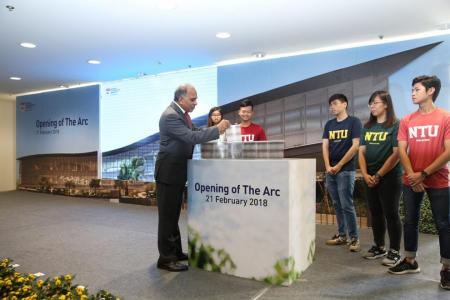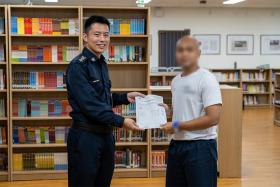With the launch of The Arc, NTU now has more 'smart' classrooms
University launches latest learning hub, which has discussion rooms, workshops and 3D-printing facilities
Classrooms with university students sitting in lecture halls listening passively to lecturers are becoming less common.
For one university, a drive to improve how students learn by encouraging more interaction and discussions has been gaining momentum.
The Nanyang Technological University (NTU) now has more than 280 "smart" classrooms on campus for such learning.
Each is equipped with multiple LED screens, flexible clustered seats and wireless communication tools.
Since 2015, NTU has done away with traditional classrooms so that students can learn more proactively and in groups.
Yesterday, NTU launched its latest learning hub, The Arc, a six-storey building with 56 smart classrooms.
The $41.5 million building is designed by local firm DCA Architects. It has 13 project discussion rooms, a room for quiet reading and a 108-seat lecture theatre. Its two lower levels have rooms that serve as workshops for engineering students.
The facility, which has a gross floor area of 18,113 sq m, also houses most of NTU's Singapore Centre for 3D Printing facilities, which will conduct research in smart technologies such as printable electronics, lightweight aircraft components and 3D-printed medical implants.
NTU president Subra Suresh said that The Arc is designed to create avenues for students to discuss ideas and interact across disciplines.
Facilities and infrastructure are important as "the way a classroom is designed influences the style of teaching, the delivery of knowledge and the effectiveness of the whole learning experience", he added.
With the new learning arrangements, termed the "flipped-classroom" model, NTU students access materials online before class.
Class time is then used for deeper learning activities such as tackling problems in teams of five or six and engaging in more discussions with professors as guides.
Third-year mechanical engineering student Edward Lim said that with the redesigned courses, students can take more ownership of their learning.
"We can learn at our own pace... we can fast-forward the recorded lectures or backtrack, compared with physical lectures," said the 23-year-old.
"Lessons are also more engaging and there's more interaction with professors."
The Arc is NTU's second learning hub, after its first, The Hive, was launched in 2015.
The Hive, nicknamed the "dim sum basket building", has 55 smart classrooms with similar features.
At the event yesterday, Professor Suresh gave an update on NTU's target to redesign at least 50 per cent of its undergraduate courses to use the flipped-classroom method by 2020.
To date, 32 per cent - or 314 courses - have been converted, with another 170 courses in the works.
The building incorporates eco-friendly features such as energy-saving LED lighting, motion sensors and solar-powered systems.
Get The New Paper on your phone with the free TNP app. Download from the Apple App Store or Google Play Store now


